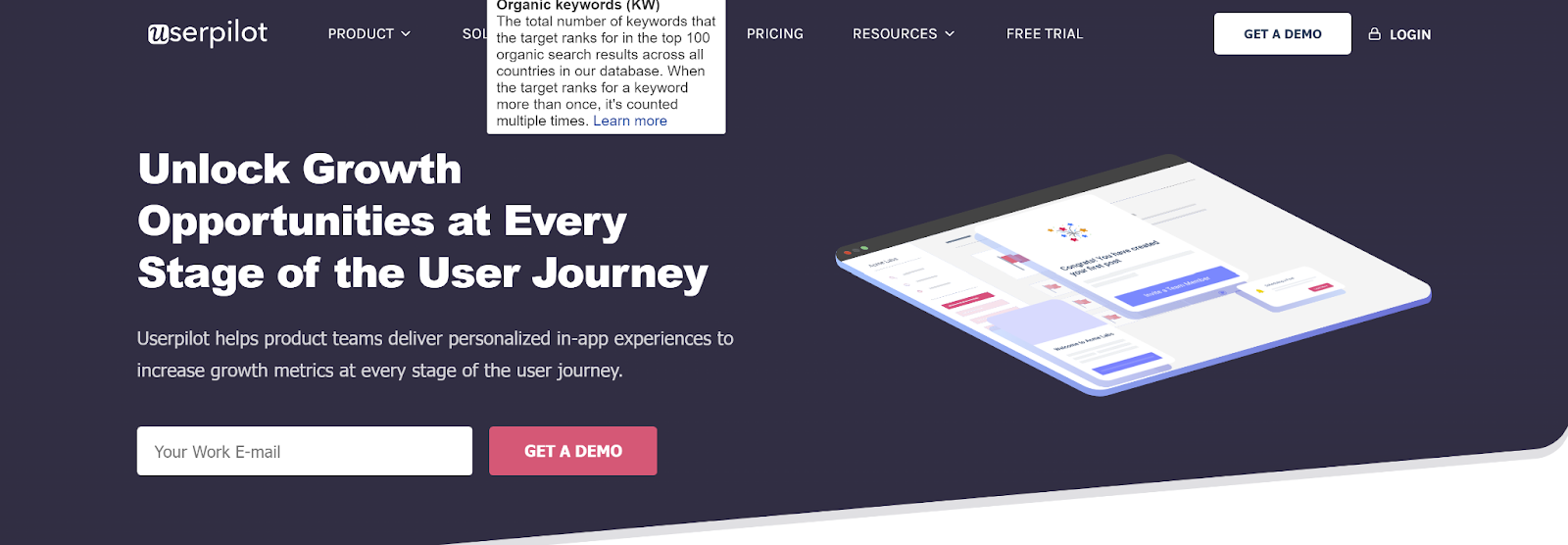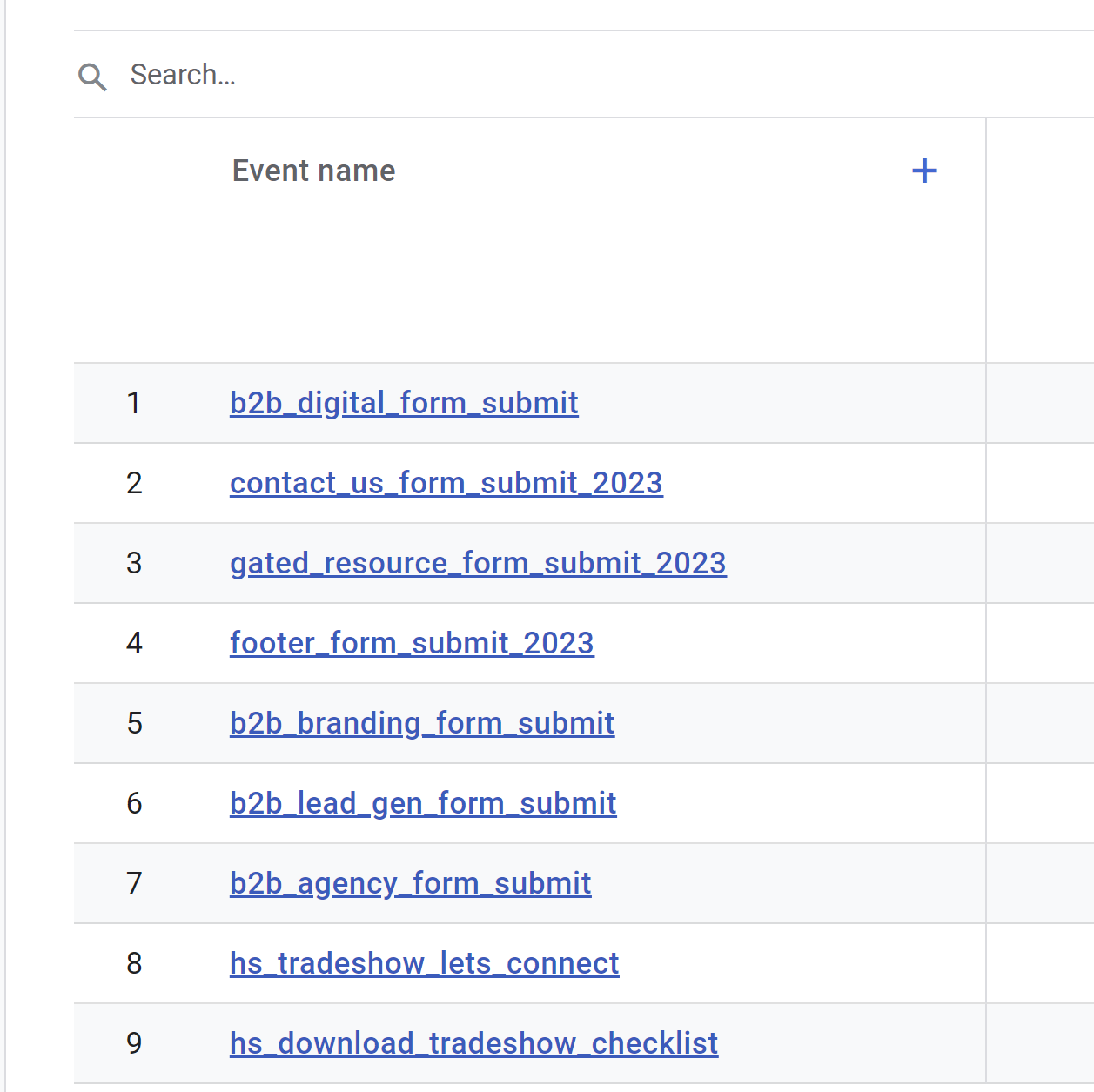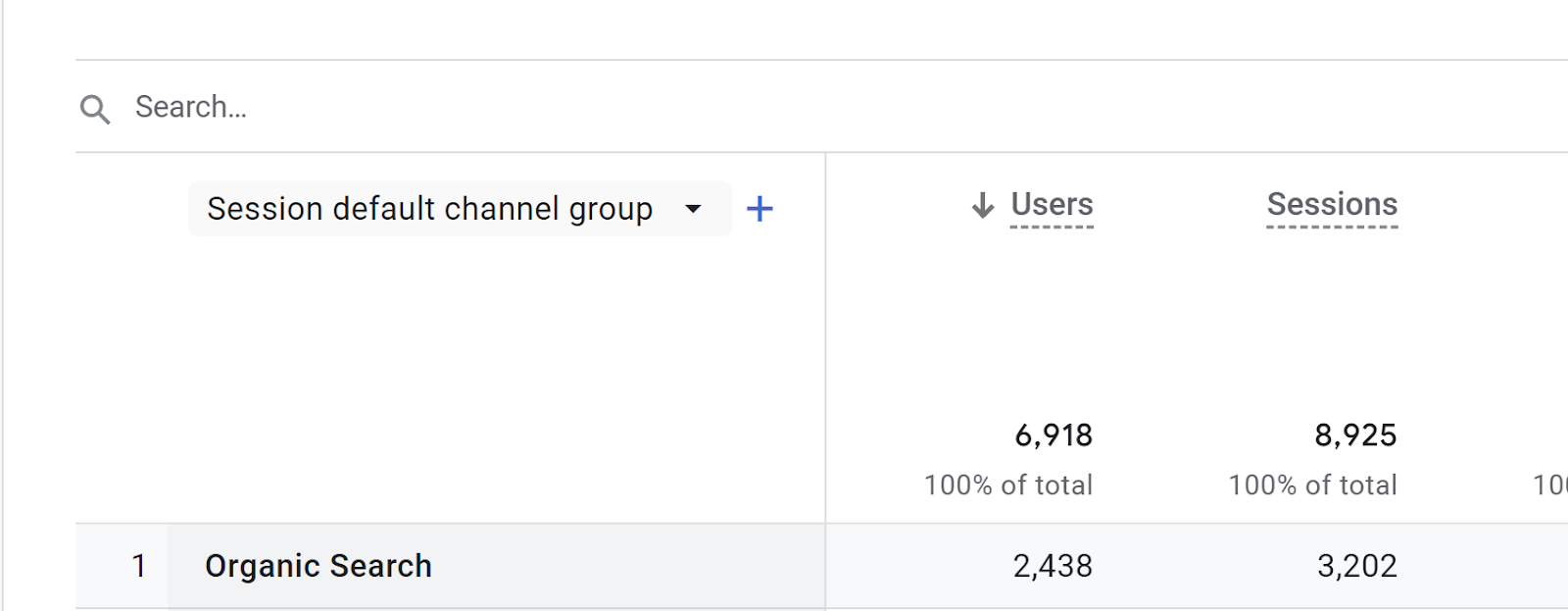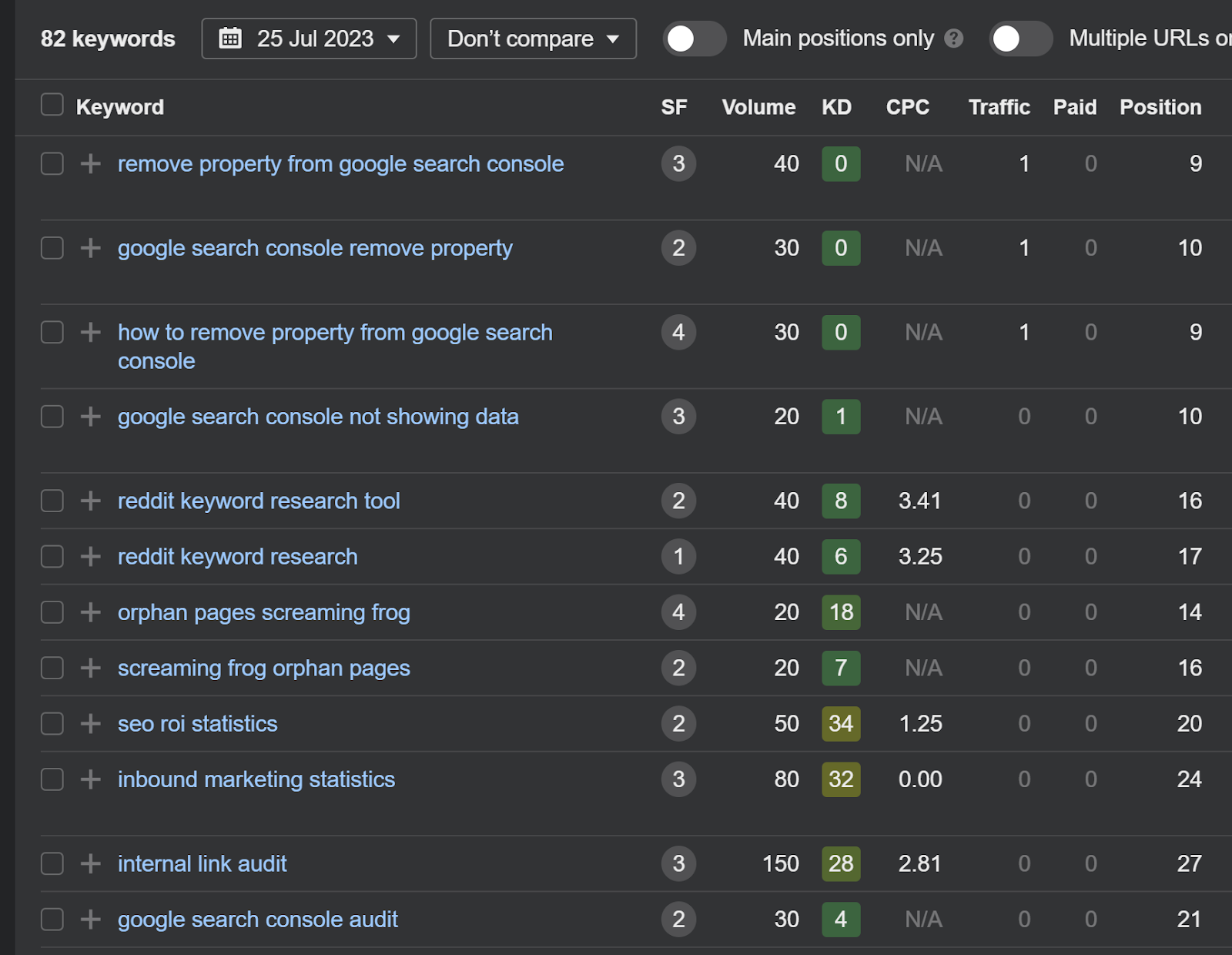TL;DR
A successful SaaS SEO strategy hinges on tracking a mix of engagement, revenue, and technical metrics—from non-branded vs. branded traffic, demos, sign-ups, and lead magnet conversions to customer lifetime value, acquisition cost, and annual recurring revenue—to reveal what’s driving growth and where to optimize.
If you’re rolling out a SaaS SEO strategy, you need rock-solid KPIs.
No question.
Without them, you’re flying blind on growth decisions.
The right KPIs will reveal what’s actually working, what's not, and where to scale.
I’ve worked with a range of SaaS brands and listed the metrics that truly matter.
In this article, I’ll walk you through the essential SaaS SEO KPIs.
Let’s get right to it.
14 Best Metrics and KPIs to Set For Your SaaS SEO Campaign
Revenue Growth: To Measure Overall SEO Success
Revenue is the top KPI for any SaaS SEO play.
SaaS SEO isn’t about collecting clicks; it’s about turning traffic into paying customers, with revenue as your main success gauge.
Tracking revenue goes beyond cold hard numbers.
It involves your entire customer journey, acquisition cost, and sales cycle.
When mapping your metrics, make sure organic revenue remains your first priority for SEO.
Product Demos and Sign-Ups: To Measure Engagement From Your SEO

Outside of organic revenue, product demos and signups should be your next highest KPI for SaaS SEO.
Why? Because product demos provide a direct measurement of engagement and interest in your product and brand, especially when they’re being captured from SEO.
When an organic visitor signs up for a product demo, they’re expressing a clear intent to learn more about your offering and your product demo team can use that to push them towards subscribing.
A product demo is a strong indicator of a qualified lead, someone who is very close to becoming a paid subscriber for your product.
All that needs to be done now is to have your product team deliver on your product’s value.
You can also use product demo signups to find strengths and weaknesses in your SEO efforts.
Is your content attracting the right audience? Are your landing pages converting?
With SaaS SEO being one of the most competitive fields, product demos and sign-ups act as a KPI that not only help you monitor your SEO campaigns performance, they can also help you understand your target audience and how you can reach them.
Marketing Qualified Leads and Sales Qualified Leads: To Measure Reach With Your SEO

Conversions and leads, similar to product demos, act as another valuable KPI for your SaaS SEO campaign.
Why should conversions and leads be used as a KPI?
Lead magnets—those valuable resources offered in exchange for contact information—serve as a powerful tool to capture qualified traffic and push them further down your marketing funnel.
They can be engaged by your sales team, be added to your email newsletter, or even offered a free trial with your product.
When a visitor signs up for a lead magnet, it shows their interest in both your brand and content.
While your sales or your product demo team is typically involved in this process, these lead magnets make it easier for your site to capture casual visitors and transform them into tangible leads.
However, you’ll still need to focus on the quality of the conversion and not quantity. Your sales and/or product team will still need to engage with them, so you want to ensure you’re only capturing qualified traffic.
You can see if your leads are being moved further down the funnel and if they are engaging with your site (or even email/social) beyond the lead magnet.
You’ll need a CRM for this of course, but by tracking your lead magnet conversions, you can not only measure your conversion rate, but you can also measure KPIs like cost per acquisition that tie directly into organic revenue. I’ll touch on this later, but your customer acquisition cost will factor in other costs outside of SEO, like sales team enablements.
Your lead magnet conversion will require some involvement from other teams, but that lead will start with SEO.
I also recommend promoting your lead magnet through other marketing channels to diversify your conversion channels. You can read my article on repurposing for other channels.
Conversion Rate: To Find Strengths and Weaknesses
While conversion rate applies for both lead magnets and product demos, they’re still a great SaaS SEO KPI to use across the entire board.
Your website’s conversion rate will give you a clear picture of how well your website and content is resonating with visitors, across your entire marketing pipeline.
You can see whether your bottom-of-the-funnel and/or top-of-the-funnel pages are converting and how you can improve them for more conversions. This can either be a product demo or a lead magnet signup.
A high conversion rate means you’re hitting the mark with your target audience across your entire website, but you’ll also want to review your conversion rate on a page-by-page basis to see which pages are underperforming.
Customer Lifetime Value: To Measure the Quality of Your Leads
Customer Lifetime Value (CLV) is another KPI that’s often not measured when it comes to SaaS SEO campaigns.
Your CLV is the total revenue you can expect from a single customer over the duration of their relationship with your brand.
This KPI goes beyond direct measurements and looks at the long-term value of each customer, whether that’s recurring revenue from them or any referrals they may bring.
Your CLV is a reflection of not just your SEO and acquisition strategies but also your customer retention efforts over a long duration of time, hence the name “lifetime value.”
A high CLV indicates that you’re not only attracting the right customers through SEO, but you’re also providing enough value to retain them and have them refer new business.
Customer Acquisition Cost: To Measure How Much it Costs to Acquire a Customer
Customer Acquisition Cost (CAC) is another KPI that should be used for every SaaS SEO campaign.
Your CAC represents the total cost of acquiring a new customer, including all marketing and sales expenses starting with SEO. From the point of contact, how much was spent to make that visitor a customer?
This will, of course, start with their first contact, and with any industry, there will be multiple touchpoints before a user becomes a lead.
This KPI is particularly important because measures how profitable your SEO efforts are.
With SEO, you’ll soon see that it has one of the lowest CAC compared to any marketing channel, assuming your SEO was done right of course.
However, a high CAC means you’re spending too much to acquire a new customer. On the other hand, a low CAC means your marketing (SEO) is working efficiently.
In simpler terms, you want to acquire a qualified lead or customer as cheaply as possible.
Non-Branded vs. Branded Traffic: For Brand Awareness Growth
Non-Branded and Branded Searches are two key areas of focus that are commonly combined into one KPI.
This is something you’ll want to avoid as branded searches will almost always dominate non-branded, especially since SEO contributes more for non-branded than branded.
Non-branded queries are searches where users find your website through keywords not directly associated with your brand.
On the other hand, branded queries are searches where users include your brand name in their search.
Branded searches usually come from users who are familiar with your brand and are looking for specific items tied to your brand like reviews and comparisons.
Not that branded queries aren’t good; they’re actually great for any SaaS SEO campaign since they have more conversion intent, but they’re difficult to measure, especially when they’re out of your control.
With non-branded, you’re capturing demand and with branded search, you’re capitalizing on demand that’s already there for your company.
The reason you’ll want to separate the two is that branded searches can come from other channels like social, email, and just general brand awareness so it’s harder to attribute directly to SEO.
Separating the two types of searches is crucial for attributing KPIs for any SaaS SEO campaign.
Read this article if you’d like to learn more about getting started with your B2B SaaS SEO.
Organic Traffic By Content: To Identify Content With Lead Potential

How would you measure your organic conversions if they didn’t start with traffic?
Having organic traffic as a KPI is about understanding which URLs are driving the most traffic to your website.
Obviously traffic can be a vanity metric, but it’s still worth it to know if your SEO is having more reach, and thus contributing to more conversions.
You can see whether your blog posts are driving more traffic than your product pages. Or if it’s the other way around.
Remember it’s not just about creating content that drives traffic (anyone can do this); it’s about creating content that resonates with your audience and pushes them further down your marketing funnel
Return On Investment from Organic: To Measure Returns and Profitability
When it comes to SaaS SEO, ROI is a metric you can’t afford to ignore and likely won’t be ignored.
Similar to your customer acquisition cost, your ROI, or return on investment is the ratio of organic profit to the cost of achieving those results.
So whether it’s your own internal efforts or agency budget, you’ll want to calculate if your investment into SEO is directly contributing to profits.
To calculate ROI, you subtract the cost of your SEO efforts from the revenue generated through organic search, then divide that by the cost of your SEO efforts, and multiply by 100 to get a percentage.
A high ROI means your SEO is working. You’re not just driving traffic—you’re driving profitable traffic.
But if your ROI is low, you’ll need to reassess your SEO efforts and find ways to increase your revenue coming from organic, whether that’s conversion rate optimization or capturing more qualified traffic.
Backlinks and Referring Domains: To See If Authority is Growing

While this KPI is SEO-specific, it’s one that can provide key insights into your SEO campaign.
With any SEO strategy, backlinks are something that can’t be ignored, They are an essential pillar (off-page SEO) of SEO.
Backlinks are links from other websites that point to your site, passing both link equity and referral traffic.
But why are backlinks so important? They’re a major factor in how search engines rank your website and content.
When your site has backlinks from relevant and trustworthy sites, search engines see your website as more credible and authoritative, which can lead to better rankings.
Think of it like a Google review for a restaurant. The more 5-star reviews you have, the more trustworthy you’ll be seen as leading to more business.
Google recognizes this trust and acts as a middleman to rank your website higher for more searches.
You can use tools like Ahrefs and SEMrush to track the quality and quantity of backlinks pointing to your site.
Exit Rate
Like bounce rate, your website’s exit rate represents the percentage of visitors who leave your site from a specific page.
This is, however, different from Bounce Rate, which measures the percentage of visitors who leave after viewing only one page.
With the recent transition to GA4, the bounce rate metric has been phased out in favor of the exit and engagement rate.
With this transition, you’ll want to familiarize yourself with this new metric so you can identify any issues that may cause your conversion rate to drop, which can ultimately lead to less revenue.
Click Through Rate (Average CTR): To Understand Click Discrepancies

Your click-through rate (CTR), like conversion rate, is a metric that’s used to gauge the performance of your URL on the SERPs and whether users are actively ignoring or clicking on your URL.
Your website’s CTR is the number of clicks your site receives divided by the number of impressions (the number of times your URL is displayed).
So why does CTR matter? It matters because it’s a strong indicator to determine if your URLs are resonating with users (compared to the competition) and if you are capturing their interest (clicks) on the SERPs.
In simpler terms, your website’s CTR is a window into user behavior and the overall effectiveness of your SEO efforts.
Rankings are usually only a quarter of the battle.
Annual Recurring Revenue from Organic: Is Your Content Leading to Quality Signups
Annual Recurring Revenue, or ARR is a KPI that should be included in every SaaS SEO strategy.
Your ARR represents the total annual value of recurring revenue coming from organic.
The reason you’ll want to include this as a KPI is because it directly ties your SEO efforts to your overall financial performance.
Like your customer lifetime value, this KPI looks at a longer picture to determine how your SEO efforts tie into recurring revenue.
If you want to calculate your ARR, you’d look at the revenue from organic customers who signed up for your recurring product and then project that over a year.
Keyword Rankings: To Measure Content Strategy Effectiveness

Ultimately where your SEO will start, keyword rankings can be used as a metric to gauge the value of traffic coming to your site.
While it isn’t my favorite KPI to use, along with traffic, you can still use rankings as a KPI to see where potential revenue can come from.
You can also use your keywords as a KPI against your website’s conversion rate.
It’s also important to understand the intent behind each keyword. If your keyword is top of the funnel, then it likely won’t generate as many conversions as a transactional keyword.
So by using keyword rankings matched with conversion rates as a KPI, you can prioritize which pages should be prioritized and which pages are underperforming.
As mentioned before, it does matter whether these keywords are being tracked as branded or non-branded.
Crawl Errors: To Ensure Technical SEO Efficiency
Crawl errors are an understated yet vital KPI to watch.
Google has to discover, crawl, and index your pages for you to rank.
If something’s misconfigured, your pages may never see the SERPs.
Make sure to keep tabs on crawl issues so your content doesn’t get lost in the shuffle.
Benchmarking KPIs against Competitor Performance
Tracking your own performance is good, but how do you stack up against rivals
Competitor benchmarking reveals if you’re lagging or leading on conversions, traffic, or backlinks.
Check if they out-rank you for core industry keywords.
See if they’re beating you on certain high-intent searches.
Dive into their link profiles to spot gaps or opportunities.
Staying on top of your competition helps you protect your SERP share and discover new keywords or content angles to go after.
The Best Tools to Track Metrics and KPIs for a SaaS SEO Campaign
When it comes to SaaS SEO KPIs, you’ll need the right tools to track them. These marketing tools will provide insights into your SEO campaign and how it’s performing across the board.
But with so many tools out there, which ones should you choose? Here are some of the best SaaS SEO tools you can use:
- SEMrush (keyword and backlink tracking)
- Ahrefs (keyword and backlink tracking)
- Google Search Console (CTR and organic click tracking)
- Google Analytics (KPI tracking)
- Google Data Studio (All of the above)
Frequently Asked Questions about KPIs
Which SaaS SEO KPI is most important?
Organic revenue, hands down. It’s directly linked to growth and profit.
Should I track ROI separately from revenue growth?
Absolutely. Revenue shows top-line growth; ROI shows if you’re earning more than you’re spending.
Do local SEO metrics matter for global SaaS brands?
Generally, global SaaS looks beyond local markets, but local SEO can help if there’s a regional focus.
What tools can assist me in comparing my performance against competitors?
SEMrush and Ahrefs are solid for tracking rival rankings, backlinks, and traffic trends.


.png)

